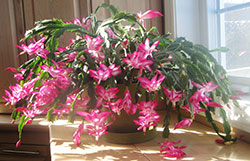Adapted by Jane Rozum, Douglas County Extension, from the CO-Horts blog.

Holiday Cacti hail from tropical rain forest areas in Brazil. This group of ‘jungle cacti’ is in the Cactus family (Cactaceae) even though they look nothing like our western US cacti. People have been growing these plants for the holidays for at least the last 150 years. In fact, these long-lived plants are considered heirlooms in many families and have been passed down through generations. There are 3 distinct types of Holiday Cacti, which are distinguished by their bloom time and other factors.
Thanksgiving Cacti – Schlumbergera truncata cultivars. Bloom in late November, have stem segments that have pointed teeth, asymmetrical flowers have bend at ovary, and yellow anthers. Most common type in floral industry.
Christmas Cacti – Schlumbergera x buckleyi Bloom around Christmastime, have stem segments that have rounded teeth, asymmetrical flowers do not bend at ovary, and purplish anthers.
Easter Cacti – Rhipsalidopsis gaerterni Bloom in April, have stems segments with rounded, scalloped edges and bristle-like hairs at the apex of the stem segments. There flowers look more symmetrical and have golden yellow anthers.
Care: Water as needed; they do well when the top inch of soil dries out between watering. Sunny east of south indoor locations are best. They are hardy enough to go outdoors in the summer, but need a semi-shade environment and should be brought indoors before the temperatures drop in the fall. All holiday cacti like to be a bit pot-bound, so repotting every three years or so should be fine. Try using a succulent potting mix when repotting, which is a bit courser and allows more air movement through the soil. Fertilization is best done during spring through late summer with a standard indoor fertilizer mix such as 15-30-15 with trace elements. Problems usually occur when over or under watered, or from such pests as mealybugs, scale insects, aphids and spider mites. Some cacti may drop unopened flower buds, which may occur from a change in temperature, light or not enough water.
Bloom: Coaxing a holiday cactus to bloom when desired will take concentrated effort. Bloom time involves either temperature or photoperiod regulation (the length of dark and light during a 24 hour period). To get the plant to produce flower buds, the following is needed:
- Bright light during the day time such as an east or south facing window.
- Continuous darkness of 14 hours per day for six weeks for complete bud set. This necessitates keeping plants in a darkened area without household lighting. As little as 2 hours of inadvertent light during this time can cause the plant to not set buds. Once there are buds on the plant, the photoperiod times are not significant.
- Nighttime temperatures between 50-59 degrees F will encourage bud set regardless of photoperiod. Daytime temperatures, however, are best kept between 60-68 degrees F for maximum flower production.



